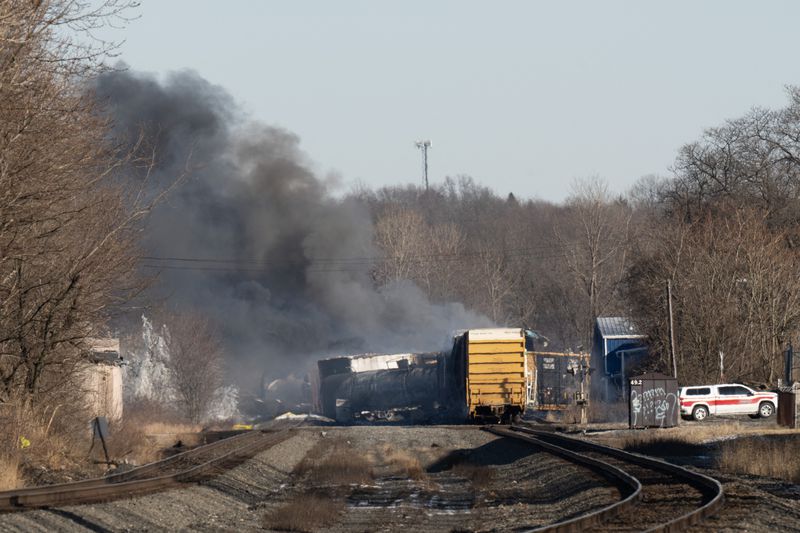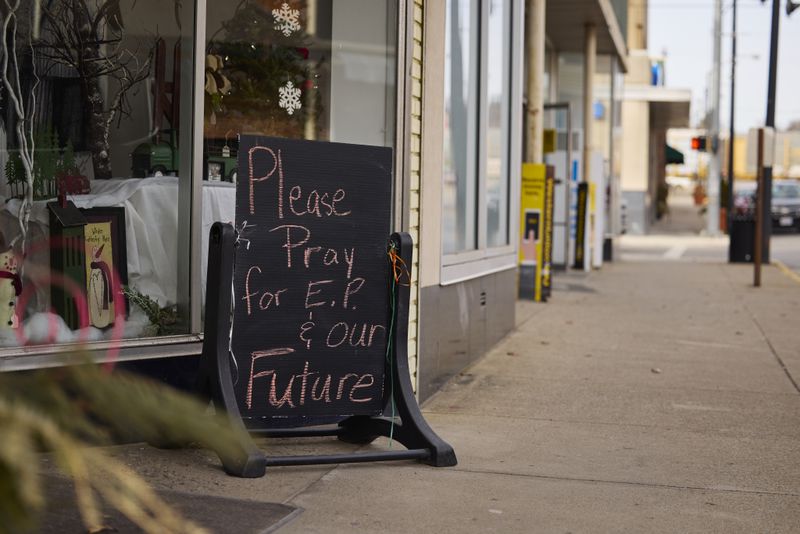
The train derailment and chemical spill was the culmination of a long trend of cost-cutting in the rail industry.
In the two weeks since 38 train cars carrying hazardous chemicals including vinyl chloride derailed in East Palestine, Ohio, there remain frustratingly few answers about exactly why it happened or what the long-term environmental impact will be.
Right now, the town’s 4,700 residents have been told returning to their homes is safe. However, residents are still wary, reporting sightings of dead fish in streams and dead chickens in backyard coops. One resident told the Washington Post this week that the air smells like nail polish remover and burning tires.
Ohio officials said the toxic chemicals released after the train crash on the outskirts of East Palestine have entered the Ohio River. Contaminants from the derailed cars were toxic to fish, but officials say drinking water has remained protected. https://t.co/LVPmxsYdAq pic.twitter.com/rFwRRlry5N
— The Associated Press (@AP) February 15, 2023
Rail workers, government officials, and industry analysts have long warned that such disasters are an expected consequence of an industry that has aggressively cut costs, slashed its workforce, and resisted regulation for years.
And this type of rail disaster does have precedent. The East Palestine derailment is not even the first vinyl chloride spill. In 2012, a train derailed and leaked 23,000 gallons of vinyl chloride into the creek in Paulsboro, New Jersey.
The critical questions now are why this type of spill happened again and what we can do to prevent the next one. There are plenty of technologies and strategies known to improve rail safety, but rail operators say they’re costly to implement. The worry is also whether there is any long-term danger to residents after the chemical clouds drift away.
What we know so far about the East Palestine train derailment and chemical spill
Thirty-eight cars in the 141-car train, stretching two miles long and operated by Norfolk Southern, were carrying a variety of chemicals including vinyl chloride. The toxic chemical is shipped as a chilled liquid but quickly turns into an explosive gas at normal outdoor temperatures.
Two days after the accident, on February 5, Ohio Gov. Mike DeWine warned that a catastrophic tanker failure “could cause an explosion with the potential of deadly shrapnel traveling up to a mile” as residents were told to evacuate.
To avert an explosion, responders decided to vent the vinyl chloride and burn it off. It produced a towering, pewter-colored column of smoke. The fumes wafted over the town’s 4,700 residents, situated almost directly between Pittsburgh and Cleveland. Residents felt the impacts firsthand, reporting headaches and nausea.

Dustin Franz/AFP via Getty Images
It wasn’t until February 12 that the US Environmental Protection Agency posted a list of the chemicals leaked from the train. In addition to vinyl chloride, the train leaked butyl acrylate, a chemical that can contaminate water. Of the 20 total cars carrying known hazardous material, 11 were among the derailed.
The EPA this week have told residents that it’s safe to return, though the agency is still screening homes and monitoring air quality. The agency says it hasn’t detected any vinyl chloride or hydrogen chloride byproducts from the spill.
On February 14, state and federal officials reported that a plume of butyl acrylate did reach the Ohio River, but that it doesn’t pose a hazard to drinking water. “The spill did flow to the Ohio River, but the Ohio River is very large and it’s a water body that’s able to dilute the pollutants pretty quickly,” said Tiffani Kavalec, the water division chief for the Ohio EPA, during a press conference on Wednesday.
During a press conference on Wednesday, DeWine noted that state officials were not informed ahead of time that the train was carrying hazardous chemicals. “This train apparently was not considered a high-hazardous material train, therefor the railroad was not required to notify anyone here in Ohio what was in the rail cars coming through our state,” he said.
Why derailments are always such train wrecks
The $80 billion US freight rail industry, spanning 140,000 route miles, is the largest in the world and, according to the US Department of Transportation, the most cost-efficient, with one of the lowest accident rates.
The expansive freight rail network runs through just about every part of the country, connecting coastal metropolises to small towns in the middle, hauling 28 percent of freight in the US.
One of the challenges in a train disaster is that so many different actors are involved with varying degrees of responsibilities. Trains and rails are owned by private companies, which are in charge of their own maintenance and inspections. That also means that a lot of information about their operations is not public. Since rail is considered to be a vital national industry, the federal government plays major roles in regulating it.
But the government’s oversight is split confusingly among several agencies:
- The Surface Transportation Board, an independent federal agency, is in charge of rail network economics, including rate-setting and construction.
- The Federal Railroad Administration (FRA) under the Department of Transportation regulates rail safety.
- The Pipeline and Hazardous Materials Safety Administration under the Transportation Department specifically has oversight over dangerous chemicals transported via rail.
- If those chemicals end up spilling, the EPA monitors contamination.
- Agencies like the National Oceanic and Atmospheric Administration can also get involved to conduct threat assessments if spills occur near water.
- And finally, the National Transportation Safety Board (NTSB) conducts the accident investigation.
Yet when a train derails, it’s local responders who are the first to the scene. They often don’t have the training and equipment to deal with chemical spills and when derailments occur in remote areas, it can take agonizing days to get the right personnel and tools. All of this can create a lot of confusion and frustration in the wake of a train wreck, particularly if hazardous chemicals are involved.
That said, the freight rail industry has improved in safety over the years. While the 1980s saw years with more than 3,000 derailments, the DOT reported 1,044 train derailments in 2022.
But rail operators are also facing pressures to cut costs from investors and competition from trucking and shipping. One way railroads are saving money is by making trains longer, so fewer personnel are required per car. Between 2008 and 2019, train lengths increased by 25 percent, according to the Government Accountability Office. There are now regular trains stretching more than three miles, often driven by just two people. The Government Accountability Office noted that the Federal Railroad Administration has no limits set on train lengths.
“There are fewer derailments over time,” said Steven Ditmeyer, a former head of the office of research and development at the FRA. “The accidents that do occur, because of the longer trains, tend to be bigger accidents — more cars and more potential damage.”
Regulators have also found more violations of hazardous materials rules. USA Today reported that federal officials found 36 percent more violations on trains over the past five years compared to the five years prior.
Another issue is that populations are growing around rail corridors. People are drawn to those regions for the same reasons that rail is there in the first place: that’s where jobs and resources are. Communities have sprung up around once-isolated sections of rail, so when a car jumps its tracks, more people are in harm’s way and many may not realize it.
“They may not have been aware of that hazard and the way that hazard can affect them,” said David Bierling, a senior research scientist at Texas A&M Transportation Institute.
So when a train does derail, the train itself and the response to it can quickly become a tangled mess and catch many by surprise.
There are ways to prevent and reduce the impact of train disasters, but the industry says they’re expensive
It’s not certain why the Norfolk Southern train derailed near East Palestine, and the NTSB investigation could take years. However, the agency said there are signs that an overheated wheel bearing played a role.
“Surveillance video from a residence showed what appears to be a wheel bearing in the final stage of overheat failure moments before the derailment,” according to an NTSB statement. “The suspected overheated wheel bearing has been collected and will be examined by engineers from the NTSB Materials Laboratory in Washington, DC.”
There are ways to detect these problems in advance. Railroads have infrared sensors that can identify components that are starting to heat up, but these sensors can be upward of 20 miles apart while an overheated bearing can seize in two or three miles. A train conductor may not receive any warning.
According to Ditmeyer, one way to find these problems in advance is with acoustic detectors. Failing wheel bearings often start making a clicking noise, sometimes hundreds of miles before they start overheating, so acoustic detectors on tracks could buy operators a lot more lead time to address potential problems. Combined with radio tags on cars, the system can identify the exact car and axle that’s causing problems.
Better brakes are another important safety measure. A new generation of electronically controlled pneumatic (ECP) brakes for trains creates redundancy in the braking system and allows trains to apply brakes to all of their cars simultaneously. That means when a conductor slams the brakes, the cars don’t all run into each other. In a report last year, the FRA said that these brakes “improve both safety and braking performance of trains” but that train companies have been reluctant to invest in them due to cost.
The Obama administration created a requirement for ECP brakes at least on trains hauling flammable materials, but the Trump administration in 2018 revoked the requirement. “The Department’s analysis shows that the expected costs of requiring ECP brakes would be significantly higher than the expected benefits of the requirement,” according to a Pipeline and Hazardous Materials Safety Administration statement.

Angelo Merendino/Getty Images
Going back to shorter trains could also be beneficial, according to Ditmeyer. It would reduce internal forces and stresses within trains so derailments wouldn’t be as damaging. It would also effectively increase staffing per train car.
But the rail industry has been cutting its workforce for years despite turning record profits. Over the last six years, train companies cut 45,000 employees, 29 percent of their workforce. “In my view, all of this has directly contributed to where we are today — rail users experiencing serious deteriorations in rail service because, on too many parts of their networks, the railroads simply do not have a sufficient number of employees,” Martin Oberman, chair of the Surface Transportation Board, said in a statement last year.
In particular, the industry has relied on a system called precision-scheduled railroading that aggressively optimizes to run as much cargo with as few workers as possible. Rail workers don’t even get paid sick days. Congress last year had to intervene to avert a rail worker strike over poor staffing and sick leave.
Investor pressure to reduce spending can be more powerful than a locomotive, so it will take even stronger regulations and oversight to enact these safety measures and prevent such disasters in the future.
“There are things that could be done, the problem is they cost money to implement,” said Ditmeyer. “If railroads start shortening trains, Wall Street will punish them.”
Part of the problem is also psychological. Train wrecks grab a lot of attention, but it’s tough to convince local, state, and federal officials to have the resources in place before disasters unfold.
“It’s really hard to maintain that focus on preparedness,” Bierling said. “We cannot and should not be complacent.”
----------------------------------------
By: Umair Irfan
Title: The East Palestine, Ohio, train wreck didn’t have to be this bad
Sourced From: www.vox.com/policy-and-politics/23597778/ohio-train-east-palestine-trainwreck-accident-chemical-norfolk
Published Date: Wed, 15 Feb 2023 22:00:40 +0000
Did you miss our previous article...
https://consumernewsnetwork.com/politics-us/the-activist-pastor-runs-to-remake-wisconsin-supreme-court






